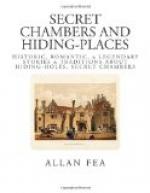On the evening of the King’s flight the company dispersed as was customary, when Ailesbury intimated, by removing his Majesty’s stockings, that the King was about to seek his couch. The Earl of Dumbarton retired with James to his apartment, who, when the house was quiet for the night, got up, dressed, and “by way of the back stairs,” according to the Stuart Papers, passed “through the garden, where Macdonald stayed for him, with the Duke of Berwick and Mr. Biddulph, to show him the way to Trevanion’s boat. About twelve at night they rowed down to the smack, which was waiting without the fort at Sheerness. It blew so hard right ahead, and ebb tide being done before they got to the Salt Pans, that it was near six before they got to the smack. Captain Trevanion not being able to trust the officers of his ship, they got on board the Eagle fireship, commanded by Captain Welford, on which, the wind and tide being against them, they stayed till daybreak, when the King went on board the smack.” On Christmas Day James landed at Ambleteuse.
Thus the old town of Rochester witnessed the departure of the last male representative of the Stuart line who wore a crown. Twenty-eight years before, every window and gable end had been gaily bedecked with many coloured ribbons, banners, and flowers to welcome in the restored monarch. The picturesque old red brick “Restoration House” still stands to carry us back to the eventful night when “his sacred Majesty” slept within its walls upon his way from Dover to London—a striking contrast to “Abdication House,” the gloomy abode of Sir Richard Head, of more melancholy associations.
Much altered and modernised, this old mansion also remains. It is in the High Street, and is now, or was recently, occupied as a draper’s shop. Here may be seen the “presence-chamber” where the dethroned King heard Mass, and the royal bedchamber where, after his secret departure, a letter was found on the table addressed to Lord Middleton, for both he and Lord Ailesbury were kept in ignorance of James II.’s final movements. The old garden may be seen with the steps leading down to the river, much as it was a couple of centuries ago, though the river now no longer flows in near proximity, owing to the drainage of the marshes and the “subsequent improvements” of later days.
The hidden passage in the staircase wall may also be seen, and the trap-door leading to it from the attics above. Tradition says the King made use of these; and if he did so, the probability is that it was done more to avoid his host’s over-zealous neighbours, than from fear of arrest through the vigilance of the spies of his son-in-law.[1]
[Footnote 1: It may be of interest to state that the illustrations we give of the house were originally exhibited at the Stuart Exhibition by Sir Robert G. Head, the living representative of the old Royalist family]
Exactly three months after James left England he made his reappearance at Kinsale and entered Dublin in triumphal state. The siege of Londonderry and the decisive battle of the Boyne followed, and for a third and last time James II. was a fugitive from his realms. The melancholy story is graphically told in Mr. A. C. Gow’s dramatic picture, an engraving of which I understand has recently been published.




